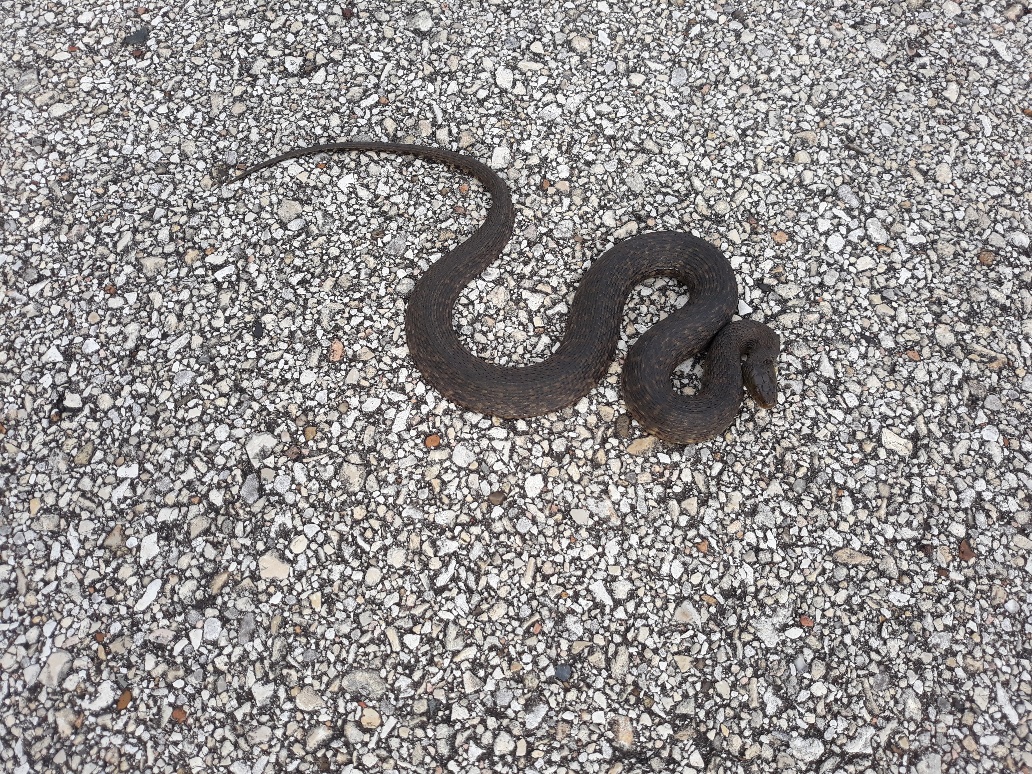By Brandt Mannchen
It’s always good to get out to reintroduce myself to the outdoors. My wife and I moved into a Montrose apartment in January from a Kingwood two-story house and the change has taken some getting used to. It’s a great location and it’s nice to be back in Houston, but the crowds can get to you.
So, I contacted my longtime buddy, David, and my new short time buddy, Brandon, and suggested we should visit the 34,000-acre Anahuac National Wildlife Refuge in Chambers County. They both were up for the trip, so I carpooled with Brandon, and we drove to the Refuge.
We got there early, and the clouds looked very dark and ominous. The weather report said rain was likely, perhaps heavy, during the morning. I was concerned but decided we would see what transpired. I went to the restroom and found a dead Broad-Banded Water Snake on the road (roadkill). Beautiful snake, a real tragedy to see!
We first drove to a nearby boat ramp to look for birds. We noticed many grackles and on the side of the road, where cattle had trampled the soil and a wetland area, large numbers of feeding White Ibis. There were many Cattle Egrets gathered around the cattle, a relationship that harkens back to their evolution on African grasslands.
We motored down part of Shoveler Pond road and saw at least 4 or 5 American Alligators, heads barely above water, watching for prey or perhaps just enjoying the wetland scenery.
We also found what appeared to be a Mississippi Green Water Snake on the road. I was afraid if this snake did not move that it too would become roadkill. A car passed by soon after I shooed the snake off the road which reenforced my concern for its’ safety and wellbeing.

We backtracked and met David and began our birding together. Periodically, we would see waves of Black-Bellied Whistling Ducks or White Ibis fly overhead. Shoveler Pond was under renovation and the water was low, allowing Rattlebox/pod to grow with their bright yellow flowers.
A few Moorhens, Tri-Colored Herons, and Back-Necked Stilts could be seen but as David said, there were fewer bird species then we normally see at Anahuac. Of course, it was a late, hot, August, fall migration had barely begun, and there had been a drought, but even so.
We admired the blooming wildflowers including the Snow-on-the-Prairie, Water Primrose, Crinum Lily, Turk’s Cap, Maximillian Sunflower, Frog Fruit, Sensitive Briar, Common Morning Glory, and Evening Rain Lily.
Then the rain hit us. It was pretty intense, for a while. But the rain fell over a short period of time and ultimately after 15 or 20 minutes had passed, left everything wet and refreshed. A big change from the long, hot. summer we have experienced this year.

In all we saw about 24 species of birds and some of the ones we saw included Great Blue Heron, Little Blue Heron, Laughing Gull, Snowy Egret, Killdeer, Crested Caracara, Red-Shouldered Hawk, Little Green Heron, Barn Swallow, Laughing Gull, Turkey Vulture, Black Vulture, and Eastern Kingbird.
We drove down and contemplated East Galveston Bay and the Smooth Cordgrass marsh that fringes and surrounds it. Brandon took some photos of the shoreline and remarked how much he appreciated where the prairie meets the saltmarsh and bay.
After about 3 hours of birding, we decided lunch sounded good and headed into Anahuac where we had some good Tex-Mex food. It was a fitting way to end our trip and we were sated and ready to drive back to the city, to our homes, and to our families relaxed, relieved, released, and refreshed.
We are lucky indeed to have places like Anahuac National Wildlife Refuge near us. It’s a guarantee that we will all be back in the future to enjoy the solitude, quiet, and relaxed slow pace of Nature’s marshes and prairies. You can’t beat it so you just have to join it.